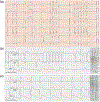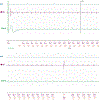Tyrosine kinase inhibitor-associated ventricular arrhythmias: a case series and review of literature
- PMID: 36411365
- PMCID: PMC10199959
- DOI: 10.1007/s10840-022-01400-z
Tyrosine kinase inhibitor-associated ventricular arrhythmias: a case series and review of literature
Abstract
Background: Tyrosine kinase inhibitors (TKIs) have been increasingly used as first-line therapy in hematologic and solid-organ malignancies. Multiple TKIs have been linked with the development of cardiovascular complications, especially atrial arrhythmias, but data on ventricular arrhythmias (VAs) is scarce.
Methods: Herein we describe five detailed cases of VAs related to TKI use in patients with varied baseline cardiovascular risk factors between 2019 and 2022 at three centers. Individual chart review was conducted retrospectively.
Results: Patient ages ranged from 43 to 83 years. Three patients were on Bruton's TKI (2 ibrutinib and 1 zanubrutinib) at the time of VAs; other TKIs involved were afatinib and dasatinib. Three patients had a high burden of non-sustained ventricular tachycardia (NSVT) requiring interventions, whereas two patients had sustained VAs. While all patients in our case series had significant improvement in VA burden after TKI cessation, two patients required new long-term antiarrhythmic drug therapy, and one had an implantable defibrillator cardioverter (ICD) placed due to persistent VAs after cessation of TKI therapy. One patient reinitiated TKI therapy after control of arrhythmia was achieved with antiarrhythmic drug therapy.
Conclusions: Given the expanding long-term use of TKIs among a growing population of cancer patients, it is critical to acknowledge the association of TKIs with cardiovascular complications such as VAs, to characterize those at risk, and deploy preventive and therapeutic measures to avoid such complications and interference with oncologic therapy. Further efforts are warranted to develop monitoring protocols and optimal treatment strategies for TKI-induced VAs.
Keywords: Arrhythmia; Sudden cardiac death; Tyrosine kinase inhibitors; Ventricular fibrillation; Ventricular tachycardia.
© 2022. The Author(s), under exclusive licence to Springer Science+Business Media, LLC, part of Springer Nature.
Figures





References
Publication types
MeSH terms
Substances
Grants and funding
- K08 HL148540/HL/NHLBI NIH HHS/United States
- R01 HL149134/NH/NIH HHS/United States
- K23 HL145017/HL/NHLBI NIH HHS/United States
- K08 HL153798/NH/NIH HHS/United States
- K08 HL148540/NH/NIH HHS/United States
- R01 HL083359/HL/NHLBI NIH HHS/United States
- K08 HL153798/HL/NHLBI NIH HHS/United States
- R01 HL149134/HL/NHLBI NIH HHS/United States
- HL83359/NH/NIH HHS/United States
- K23 HL145017/NH/NIH HHS/United States
- K08 HL148540/NH/NIH HHS/United States
- K08 HL153798/NH/NIH HHS/United States
- K23 HL145017/NH/NIH HHS/United States
- R01 HL149134/NH/NIH HHS/United States
- HL83359/NH/NIH HHS/United States
LinkOut - more resources
Full Text Sources
Medical

